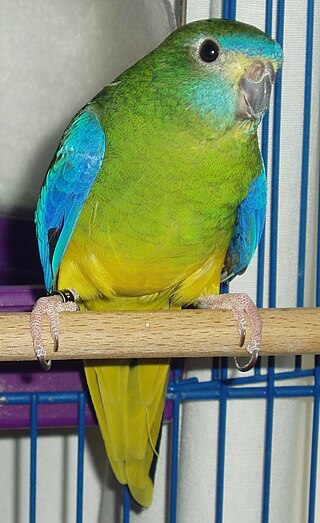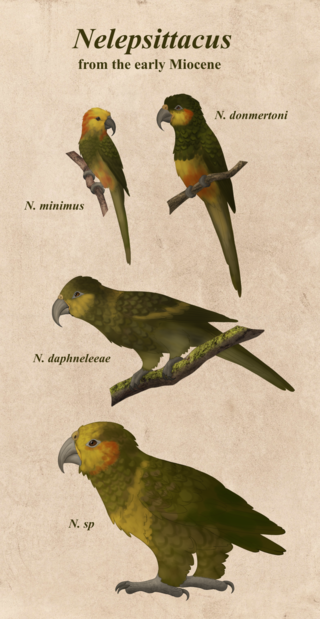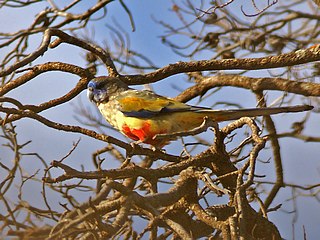
The true parrots are about 350 species of hook-billed, mostly herbivorous birds forming the two superfamilies Psittacidae, and Psittaculidae, two of the three superfamilies in the biological order Psittaciformes (parrots). True parrots are widespread, with species in Mexico, Central and South America, sub-Saharan Africa, India, Southeast Asia, Australia, and eastwards across the Pacific Ocean as far as Polynesia. The true parrots include many of the familiar parrots including macaws, conures, lorikeets, eclectus, Amazon parrots, grey parrot, and budgerigar. Most true parrots are colourful and flighted, with a few notable exceptions.

A broad-tailed parrot is any of about 35–40 species belonging to the tribe Platycercini. The members of the tribe are small to medium in size, and all are native to Australasia, Australia in particular, but also New Zealand, New Caledonia, and nearby islands.

The red-rumped parrot, also known as the red-backed parrot or grass parrot, is a common bird of south-eastern Australia, particularly in the Murray-Darling Basin.

The crimson rosella is a parrot native to eastern and south eastern Australia which has been introduced to New Zealand and Norfolk Island. It is commonly found in, but not restricted to, mountain forests and gardens. The species as it now stands has subsumed two former separate species, the yellow rosella and the Adelaide rosella. Molecular studies show one of the three red-coloured races, P. e. nigrescens, is genetically more distinct.

The eastern bluebonnet, also known as the greater bluebonnet, is an Australian parrot, one of two species in the genus Northiella. It was originally included in the genus Psephotus but due to distinctive physical and behavioural differences was reclassified into its own genus in 1994 by ornithologists and taxonomists Christidis and Boles. The bluebonnet is a medium-sized inland parrot commonly found in the interior of southeastern and central-southern Australia. It is adapted to life in semi-arid regions but can also flourish in regions of medium rainfall towards the eastern and southern extremities of its range.

The genus Neophema is an Australian genus with six or seven species. They are small, dull green parrots differentiated by patches of other colours, and are commonly known as grass parrots. The genus has some sexual dichromatism, with males having brighter hues.

Rosellas are in a genus that consists of six species and nineteen subspecies. These colourful parrots from Australia are in the genus Platycercus. Platycercus means "broad-tailed" or "flat-tailed", reflecting a feature common to the rosellas and other members of the broad-tailed parrot tribe. Their diet is mainly seeds and fruit.

Psephotellus is a genus of medium sized Australian parrots. Four species found across the country are recognised, one is presumed to have become extinct.

The tribe Pezoporini is the sister clade of the tribe Platycercini that contains the broad-tailed parrots.

Pezoporus is a genus of parrot endemic to Australia. It contains two species: the night parrot and the ground parrot which is divided into three subspecies. The night parrot was previously separated in a distinct genus, Geopsittacus. The genus is part of the tribe Pezoporini and subfamily Platycercinae.

The neotropical parrots or New World parrots comprise about 150 species in 32 genera found throughout South and Central America, Mexico, the Caribbean islands and (formerly) the southern United States. Among them are some of the most familiar and iconic parrots, including the blue and gold macaw, sun conure, and yellow-headed amazon.

The ground parrot is a parrot endemic to Australia. It is one of only four ground-dwelling parrots in the world, the others being the closely related night parrot, the Antipodes parakeet, and the kākāpō from New Zealand.

The turquoise parrot is a species of parrot in the genus Neophema native to Eastern Australia, from southeastern Queensland, through New South Wales and into North-Eastern Victoria. It was described by George Shaw in 1792. A small lightly built parrot at around 20 cm (7.9 in) long and 40 g in weight, it exhibits sexual dimorphism. The male is predominantly green with more yellowish underparts and a bright turquoise blue face. Its wings are predominantly blue with red shoulders. The female is generally duller and paler, with a pale green breast and yellow belly, and lacks the red wing patch.

The green rosella or Tasmanian rosella is a species of parrot native to Tasmania and Bass Strait islands. It was described by the German naturalist Johann Friedrich Gmelin in 1788, and named on the mistaken assumption it came from New Caledonia. At 14.5 in (37 cm) long it is the largest species of the rosella genus, Platycercus. Two subspecies are recognised. The green rosella's underparts, neck and head are yellow, with a red band above the beak and violet-blue cheeks. The back is mostly black and green, and its long tail blue and green. The sexes have similar plumage, except the female has duller yellow plumage and more prominent red markings, as well as a smaller beak. Juvenile and immature birds have predominantly green plumage.

A feral parrot is a parrot that has adapted to life in an ecosystem to which it is not native. The birds are often descended from pets that have escaped or been deliberately released. Many species of parrots are highly social, and like to gather in large flocks. Not all feral parrots are able to adapt to life outside of captivity, although having a pre-existing nearby parrot colony can assist with the adaptation process.

The Norfolk parakeet, also called Tasman parakeet, Norfolk Island green parrot or Norfolk Island red-crowned parakeet, is a species of parrot in the family Psittaculidae. It is endemic to Norfolk Island.

Nelepsittacus is a genus of extinct New Zealand parrots that is closely related to the genus Nestor. It consists of four species, of which three have been named so far. The species are all known from the early Miocene Saint Bathans Fauna from the Lower Bannockburn Formation in Otago in New Zealand.

New Zealand is geographically isolated, and originally lacked any mammalian predators, hence parrots evolved to fill habitats from the ground dwelling kākāpō to the alpine dwelling kea as well as a variety of forest species. The arrival of Māori, then European settlers with their attendant animals, habitat destruction and even deliberate targeting, has resulted in their numbers plummeting. Today one species is on the brink of extinction and three other species range from Vulnerable to Critically Endangered, all impacted by invasive species. Further parrot species were not introduced by acclimatisation societies, but occasional releases, both deliberate and accidental, have resulted in self-sustaining populations of some Australian species. New Zealand was identified among the highest priority countries for parrot conservation in the world, due to its parrot diversity, endemism, threats, and having more threatened parrot species than expected.

The term "bluebonnet" refers to the Northiella genus which is subdivided into two species of Australian parrots, these are the Eastern Bluebonnet and the Naretha Bluebonnet. This genus is named in honor of Australian ornithologist Alfred John North.
















